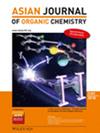3,6 -二(叔丁基)萘- 1,8 -二基二(叔丁基)硝基中的四中心二电子键
IF 2.8
4区 化学
Q1 CHEMISTRY, ORGANIC
引用次数: 0
摘要
发现了标题化合物的三个多晶型,显示了一个首尾相连的(N−O)2四元环。α和β相在140 K左右发生了可逆的结构相变,而γ相是独立的。原子间O⋅⋅N距离为范德华半径总和的79 ~ 81%,与α相的磁性和ESR研究中观察到的抗磁性一致。在固态ESR中记录到热可达的零场分裂模式,采用单重态-三重态(ST)模型得到2Jobs/kB=−1.87(8)×103 K (H=−2JS1⋅S2)。SQUID结果显示2Jobs/kB= -2.159 (5)×103 K。由于在萘核上引入了两个叔丁基,在430 K以下,三重态的生成是可逆的。晶体学数据和QTAIM分析的剩余电子密度图表明(N−O)2具有四中心二电子σ键性质。得到了两个DFT优化结构,其中2Jcalc/kB= - 8864 K为共价模型,- 974 K为双键模型。因此,我们可以提出一个涉及两步平衡的机制;共价态和双基态之间的化学平衡以及双基态中S态和T态之间随后的自旋平衡。本文章由计算机程序翻译,如有差异,请以英文原文为准。
Four‐Center Two‐Electron Bond in 3,6‐Di(tert‐butyl)naphthalene‐1,8‐diyl Bis(tert‐butyl Nitroxide)
Three polymorphs of the title compound were found, showing a head‐to‐tail (N−O)2 four‐membered ring. The α and β phases underwent a reversible structural phase transition across ca. 140 K, while the γ phase was independent. The interatomic O ⋅ ⋅ ⋅ N distances are 79–81 % of the sum of the van der Waals radii, consistent with the diamagnetic properties observed in the magnetic and ESR studies for the α phase. A thermally accessible zero‐field splitting pattern was recorded in solid‐state ESR, and applying a singlet‐triplet (ST) model afforded 2Jobs/kB=−1.87(8)×103 K (H=−2JS1 ⋅ S2). The SQUID results showed 2Jobs/kB=–2.159(5)×103 K. Thanks to the introduction of two tert‐butyl groups on the naphthalene core, the generation of triplet species is reversible below 430 K. The residual electron density map from the crystallographic data and the QTAIM analysis indicate a four‐center two‐electron σ‐bond nature in (N−O)2. Two DFT‐optimized structures were given, featuring 2Jcalc/kB=−8864 K as a covalent model and −974 K as a biradical model. Thus, we can propose a mechanism involving two‐step equilibria; a chemical equilibrium between the covalent and biradical forms and a subsequent spin equilibrium between the S and T states in a biradical.
求助全文
通过发布文献求助,成功后即可免费获取论文全文。
去求助
来源期刊

Asian Journal of Organic Chemistry
CHEMISTRY, ORGANIC-
CiteScore
4.70
自引率
3.70%
发文量
372
期刊介绍:
Organic chemistry is the fundamental science that stands at the heart of chemistry, biology, and materials science. Research in these areas is vigorous and truly international, with three major regions making almost equal contributions: America, Europe and Asia. Asia now has its own top international organic chemistry journal—the Asian Journal of Organic Chemistry (AsianJOC)
The AsianJOC is designed to be a top-ranked international research journal and publishes primary research as well as critical secondary information from authors across the world. The journal covers organic chemistry in its entirety. Authors and readers come from academia, the chemical industry, and government laboratories.
 求助内容:
求助内容: 应助结果提醒方式:
应助结果提醒方式:


